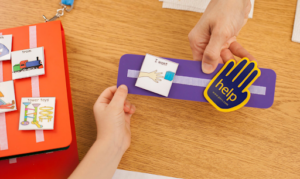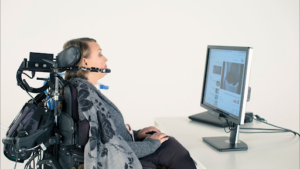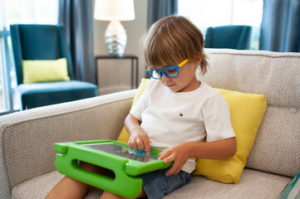What does smiling at a neighbor, sending a text, and ordering food by pointing to menu pictures have in common? They are all examples of AAC. By writing this blog, I am utilizing AAC to convey this message to you. So, the question is…
What is AAC?
Augmentative or Alternative Communication (AAC) refers to all the ways that we convey our thoughts and feelings without talking. Our world is full of AAC and for good reason- AAC is essential for well-rounded and effective communication across all stages of life.
Individuals with speech, language, or voice disorders especially benefit from use of AAC to help increase their functional communication skills (Drager et al., 2010). Research has shown that use of AAC can increase expressive language skills, increase language comprehension, increase positive behaviors, increase social competence, and even support verbal language skills (Light et al., 2003; Millar et al., 2006).
People with communication disorders may benefit from additional support to incorporate AAC into their daily lives. Speech-language pathologists are trained to assess, recommend, and implement AAC with clients, based on their strengths and needs. At PlayWorks, we empower clients by using various types of AAC throughout therapy, as well as encourage AAC in home carryover activities.
What are the types of AAC?
There are two general categories of AAC: unaided and aided systems.
Unaided AAC refers to the use of the body to communicate. Examples of unaided AAC include:
- facial expressions
- gestures
- body language
- sign language
- non-word vocalizations (i.e., laughing, crying, cooing)

Aided AAC refers to communication supported by supplemental tools or equipment. These tools can be categorized as either low-tech AAC and high-tech AAC. Low-tech AAC includes tools that do not involve electronics or use of batteries. Examples include:
- Writing
- Objects
- Pictures and symbols
- Picture Exchange Communication System (PECS)
- Communication boards or books


High-tech AAC refers to tools that use electricity, electronics, or batteries to operate. Some examples include:
- Speech-generating devices
- Recorded or digitized buttons/devices (such as the Staples “easy” button)
- Computers (e-mail, texts, etc.)
- AAC software on tablets, computers, phones, and other devices


Many dedicated high-tech AAC systems have supplemental equipment available that makes communication access and transportation easier. For example, certain devices have external speakers to help others better hear the speech-generated message. Cameras may be attached to track eye movements for those people who use eye gaze to create their messages. Devices may have special stands or carrying cases to make them more accessible for those in wheelchairs.
At PlayWorks, we support the use of low-tech and high-tech AAC by creating custom communication boards, using props or objects, and utilizing AAC applications on speech-generating devices.
Determining AAC needs
Communication is most effective when it’s multi-modal, or occurs in a variety of ways. Therefore, in order to best support individuals with communication delays and disorders, it’s important to implement and teach both unaided and aided AAC. Research shows that no prerequisite skills are required before starting AAC (Light & McNaughton, 2012; Snell et. al, 2010). However, it is important to consider a variety of personal factors when starting, including:
- Current profile (physical/motor, language, cognitive, sensory, etc.)
- Strengths and areas of need
- Available communication partners
- Setting or contexts in which the person will need to communicate
- Resources available to both the individual and the communication partners
- Individual preferences
Your therapy team will then use this information to determine which AAC tools and strategies will be most appropriate to trial, implement, and possibly purchase!
No matter a person’s age or ability level, AAC is a fundamental part of increasing functional communication. In my upcoming AAC blog posts, I will address common misconceptions surrounding use of AAC and expand upon ways to support an individual in their AAC journey.
Questions or Concerns?
If you have questions or concerns about your child’s development, please contact us at info@playworkschicago.com or 773-332-9493. The Speech-Language Pathology team and the Assistive Technology team are available to provide individualized AAC recommendations based on your child’s needs.
Nicole Sherlock, MA, CCC-SLP
Assistive Technology Co-Coordinator
Citations & References:
American Speech-Language-Hearing Association. (n.d.). Augmentative and Alternative Communication (AAC). https://www.asha.org/public/speech/disorders/aac/.
American Speech-Language-Hearing Association. (n.d.). Augmentative and Alternative Communication (AAC). https://www.asha.org/practice-portal/professional-issues/augmentative-and-alternative-communication/#collapse_1
Crowe B, Machalicek W, Wei Q, Drew C, Ganz J. Augmentative and Alternative Communication for Children with Intellectual and Developmental Disability: A Mega-Review of the Literature. J Dev Phys Disabil. 2021 Mar 31:1-42. doi: 10.1007/s10882-021-09790-0. Epub ahead of print. PMID: 33814873; PMCID: PMC8009928.
Drager, K., Light, J., & McNaughton, D. Effects of AAC interventions on communication and language for young children with complex communication needs. Journal of Pediatric Rehabilitation Medicine. 2010;3(4):303–310. doi: 10.3233/PRM-2010-0141.
